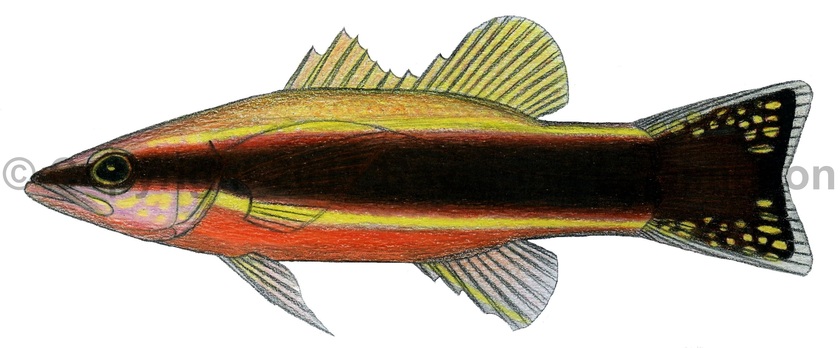
Common Name
Wrasse Bass
Year Described
Stark & Courtenay, 1962
Identification
Dorsal Fin: VIII, 12
Anal Fin: III, 8
Pectoral Fin: 13-14
Pelvic Fin: I, 5
Gill Rakers: 16-18 (first arch)
Lateral Line Scales: 44
Vertebrae: 24 (10 precaudal, 14 caudal)
Body elongate, compressed, and robust. Head pointed. Forehead profile straight. Eye moderate to large. Mouth extends to rear half of orbit. Lower jaw projects. Rear corner of maxilla with a blunt ventral projection. Preopercle serrated. Opercle with one stout middle spine and two accessory spines. Spiny and soft dorsal fins appear well separated, with 6th and 7th spine very short. Dorsal, anal and caudal fin with rounded tips. Caudal peduncle strong. Tail slightly forked with rounded lobes. Body and entire head with small ctenoid, deciduous scales. Fin membranes scaled.
Color
Basal body color pale rose to red, with yellow spotting on the dorsum and lower head. A dark brown to dark red lateral stripe passes through eye and widens posteriorly. This stripe is bordered dorsally and ventrally by a pale to bright yellow stripe. Another yellow stripe often runs from the rear of the eye in the middle of the dark stripe. Caudal fin the same color as the body stripe, with broad yellow borders dorsally and ventrally and many yellow spots. The posterior part of the tail has a dark blotch and a white posterior edging. Other fins are pale reddish to rose with darker anterior margins.
Size
Maximum size to 130mm TL.
Habitat
A deep reef species (20-150m) living around hard structure.
Range
North Carolina to S. Florida and the northern Gulf of Mexico.
References
McEachran, J.D. and J.D. Fechhelm. 2005. Fishes of the Gulf of Mexico. Volume 2: Scorpaeniformes to Tetraodontiformes. University of Texas Press, Austin. i-viii +1-1004.
Other Notes
The genus Chorististium had been erected in the past for these smaller Liopropoma with more separated dorsal fins (rubre, carmabi, mowbrayi, eukrines in our area). The genus Pikea was used for larger Liopropoma with notched but noticeably connected dorsal fins (aberrans, olneyi, santi in our area). Recent phylogenetic work shows Liopropoma is paraphyletic with the inclusion of Bathyanthias in the phylogeny, so they will eventually all be lumped into Liopropoma or several new genera will be proposed for the different clades.